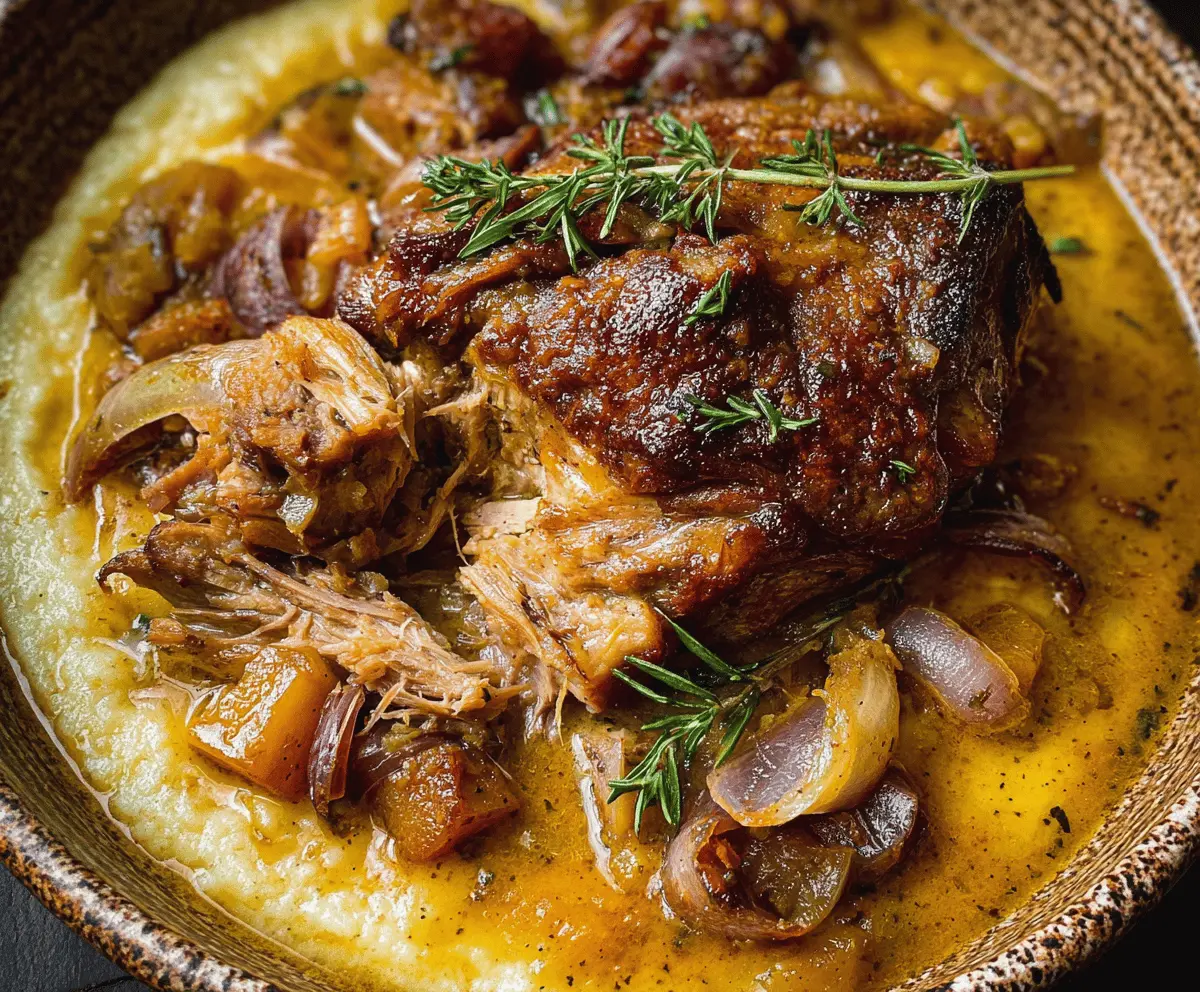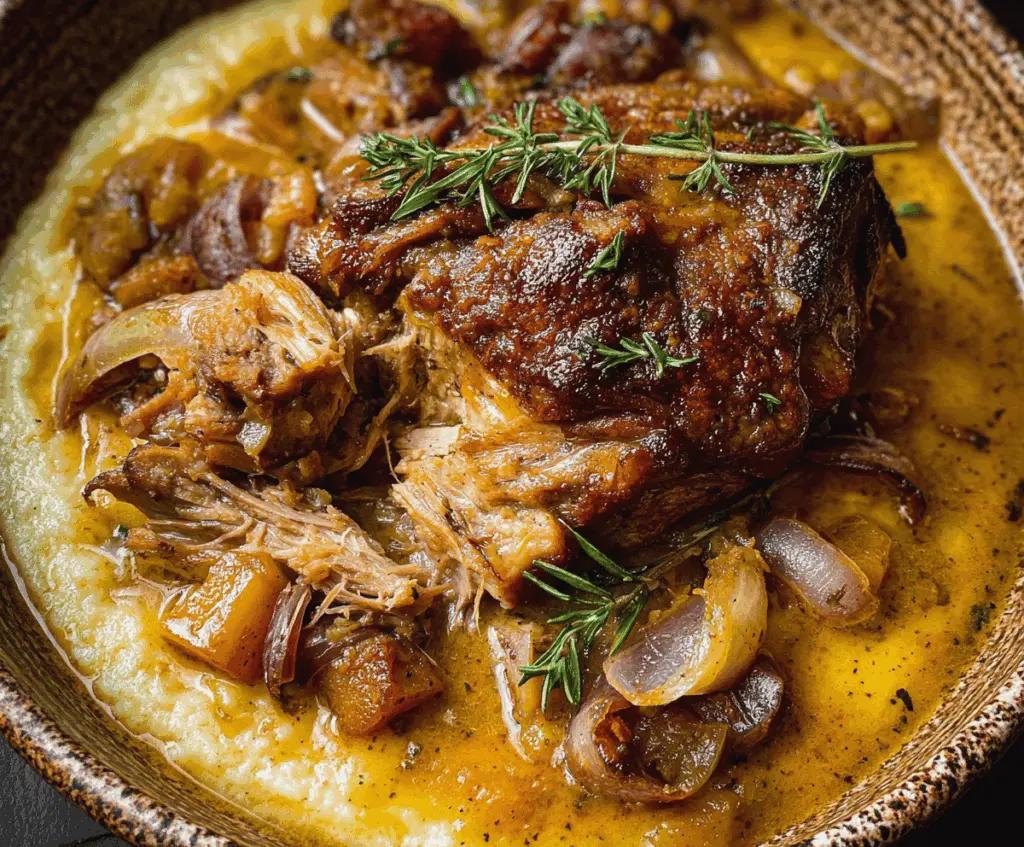Apple Cider Braised Pork Shoulder is a cozy, mouth-watering dish that blends tender, slow-cooked pork with the sweet and tangy flavors of apple cider. The pork becomes so soft it practically falls apart, soaking up the rich, fruity sauce that makes every bite special. This is a dish that feels like a warm hug on a chilly day.
I love making this recipe when I want something comforting but not complicated. I usually let it braise for a long time so the flavors really marry, and the kitchen fills with the wonderful smell of apples, herbs, and spice. It’s one of those recipes that makes you feel like a kitchen pro even if it’s actually super easy.
My favorite way to serve this is over creamy mashed potatoes or even buttery noodles to soak up all the extra sauce. I also like adding a simple side of roasted veggies or a crisp green salad to balance out the richness. This dish often turns into leftovers that taste just as good, if not better, the next day—perfect for easy lunches or quick dinners.
Key Ingredients & Substitutions
Pork Shoulder: This cut is perfect for slow cooking because of its marbling, which keeps the meat juicy and tender. If you can’t find pork shoulder, pork butt or even pork leg can work but may be leaner.
Apple Cider: It adds a sweet and tangy flavor that’s central to this dish. If unavailable, you can use apple juice or a mix of white wine and a splash of apple vinegar for a similar taste.
Apples: Tart apples like Granny Smith balance the rich pork nicely. You could swap with other firm, slightly tart apples such as Braeburn or Honeycrisp.
Fresh Herbs: Rosemary and thyme give earthiness. If fresh isn’t on hand, dried versions work – just use about one-third the amount.
Apple Cider Vinegar: This adds bright acidity to balance sweetness. White wine vinegar or lemon juice can be substitute options in a pinch.
How Do You Get the Pork Tender and Full of Flavor?
Slow braising is key here. It breaks down collagen and fat in the pork shoulder, turning it tender and juicy.
- Sear First: Browning the pork develops deep flavor through the Maillard reaction. Don’t rush this step.
- Low and Slow Cooking: Once in the oven, keep the heat low (around 300°F) so the meat softens without drying out. Plan for 3-4 hours.
- Cover Tightly: Use a tight lid or foil to trap steam and moisture, helping the pork cook evenly.
- Check Liquid Levels: Make sure there is enough braising liquid but don’t submerge the meat completely—about halfway up is just right.
Following these tips will give you a juicy, flavorful pork shoulder that falls apart with a fork. Plus, the apple cider sauce nicely marries the sweet and savory flavors.

Equipment You’ll Need
- Large Dutch oven or heavy ovenproof pot – I prefer this for even heat and easy oven transfer.
- Wooden spoon – perfect for scraping up browned bits and stirring the sauce.
- Sharp knife and cutting board – essential for chopping apples, onions, and herbs.
- Meat thermometer (optional) – helps ensure the pork is perfectly cooked and tender.
- Oven mitts – for safe handling of hot pots during braising.
Flavor Variations & Add-Ins
- Use dried herbs like sage or rosemary instead of fresh if fresh isn’t available; these add a different earthy note.
- Finish the sauce with a splash of bourbon or apple brandy for a richer, more complex flavor.
- Swap the apples for pears for a sweeter, softer fruit addition that pairs well with pork.
- Add a pinch of cayenne or smoked paprika to give the dish a little kick or smoky depth.

Apple Cider Braised Pork Shoulder
Ingredients You’ll Need:
For the Pork and Braising Liquid:
- 3 to 4 pounds pork shoulder (bone-in or boneless)
- Salt and freshly ground black pepper, to taste
- 2 tablespoons olive oil
- 1 large yellow onion, sliced into wedges
- 3 cloves garlic, minced
- 2 medium apples, peeled, cored, and diced (preferably Granny Smith)
- 1 ½ cups apple cider (unfiltered if possible)
- 1 cup low-sodium chicken broth
- 2 tablespoons apple cider vinegar
- 2 tablespoons brown sugar (optional, for sweetness)
- 2 sprigs fresh rosemary
- 2 sprigs fresh thyme
- 1 teaspoon ground cinnamon
- ½ teaspoon ground allspice or cloves (optional)
- 2 tablespoons butter (optional, for finishing)
How Much Time Will You Need?
This recipe takes about 20 minutes to prepare and sear the pork, plus 3 to 4 hours for slow braising. Plan on about 4 hours total to get that tender, flavorful pork shoulder you love.
Step-by-Step Instructions:
1. Prepare and Season the Pork:
Start by drying your pork shoulder well with paper towels. This helps with browning. Then, sprinkle salt and black pepper all around the meat generously.
2. Brown the Pork:
Heat olive oil in a large, heavy pot or Dutch oven over medium-high heat. When hot, put the pork shoulder in and sear for 4-5 minutes on each side until it’s beautifully browned. Once done, take it out and set aside.
3. Cook the Onions, Garlic, and Apples:
Turn the heat down to medium. Add the onion wedges to the pot and cook, stirring occasionally, until they soften and turn golden, about 5 minutes. Then add the garlic and cook for 1 more minute until fragrant. Toss in the diced apples and cook for another 3-4 minutes to soften them slightly.
4. Deglaze and Add the Braising Liquids:
Pour in the apple cider, and scrape the bottom of the pot with a wooden spoon to loosen all those tasty browned bits. Add the chicken broth, apple cider vinegar, and brown sugar if you’d like a touch more sweetness. Stir in the cinnamon, allspice or cloves, rosemary, and thyme.
5. Return Pork and Begin Braising:
Place the browned pork shoulder back into the pot, nestling it gently among the apples and onions. The liquid should come about halfway up the meat—if not, add a splash more broth or cider.
6. Slow Cook in the Oven:
Bring the liquid just to a simmer, then cover the pot with a tight lid and place it in an oven preheated to 300°F (150°C). Let it braise for 3 to 4 hours. You want the pork to be fork-tender and easy to pull apart. Check once or twice during cooking to make sure there’s enough liquid, adding more if needed.
7. Finish Up the Sauce:
Once the pork is done, carefully remove it and tent it with foil to keep warm. If you want a thicker sauce, place the pot back on the stove over medium heat and simmer until it reduces slightly. Stir in butter for a nice, glossy finish and season with salt and pepper to taste.
8. Serve and Enjoy:
Slice or shred the pork shoulder and serve over creamy mashed potatoes, polenta, or grits. Spoon the apple-onion sauce over the top, and garnish with fresh rosemary for a lovely touch.
Can I Use Frozen Pork Shoulder for This Recipe?
Yes, but be sure to fully thaw it in the refrigerator overnight before cooking. Cooking frozen pork shoulder can result in uneven cooking and longer braising time.
Can I Make This Recipe in a Slow Cooker?
Absolutely! After searing the pork and sautéing the aromatics, transfer everything to a slow cooker. Cook on low for 6-8 hours or until the pork is tender and easily pulls apart.
How Should I Store Leftovers?
Store leftover pork and sauce in an airtight container in the refrigerator for up to 3 days. Reheat gently on the stove or in the microwave to prevent drying out the meat.
Can I Substitute Apple Cider with Something Else?
If you don’t have apple cider, you can use apple juice, white grape juice, or a mix of chicken broth with a splash of apple cider vinegar for a similar flavor profile.



